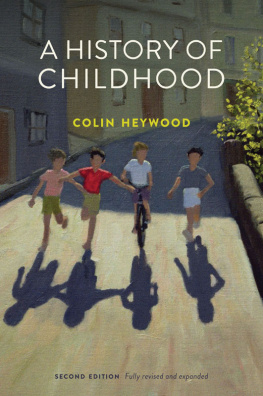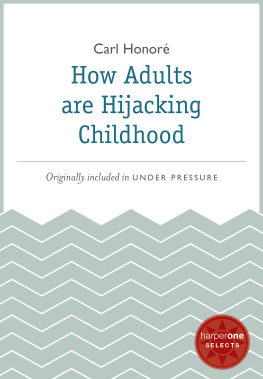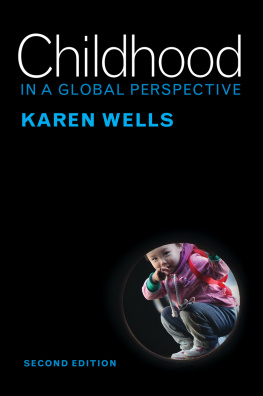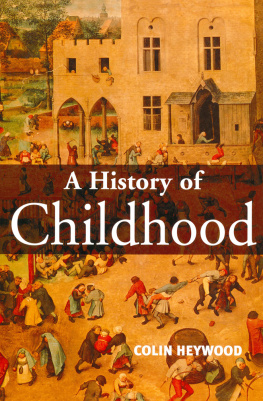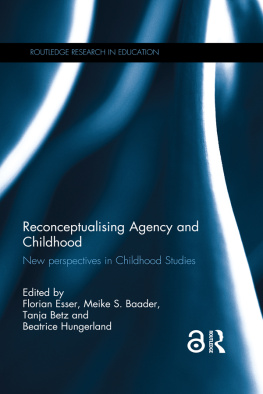
Copyright page
Copyright Colin Heywood 2018
The right of Colin Heywood to be identified as Author of this Work has been asserted in accordance with the UK Copyright, Designs and Patents Act 1988.
First edition published in 2001 by Polity Press in association with Blackwell Publishing Ltd.
This edition published in 2018 by Polity Press
Polity Press
65 Bridge Street
Cambridge CB2 1UR, UK
Polity Press
101 Station Landing
Suite 300,
Medford, MA 02155
USA
All rights reserved. Except for the quotation of short passages for the purpose of criticism and review, no part of this publication may be reproduced, stored in a retrieval system or transmitted, in any form or by any means, electronic, mechanical, photocopying, recording or otherwise, without the prior permission of the publisher.
ISBN-13: 978-0-7456-5165-1
ISBN-13: 978-0-7456-5166-8 (pb)
A catalogue record for this book is available from the British Library.
Library of Congress Cataloging-in-Publication Data
Names: Heywood, Colin, author.
Title: A history of childhood / Colin Heywood.
Description: Cambridge, UK ; Medford, MA : Polity Press, 2017. | Earlier edition: 2001. | Includes bibliographical references and index.
Identifiers: LCCN 2017024667 (print) | LCCN 2017036680 (ebook) | ISBN 9781509525379 (Mobi) | ISBN 9781509525386 (Epub) | ISBN 9780745651651 (hardback) | ISBN 9780745651668 (pbk.)
Subjects: LCSH: ChildrenHistory. | ChildrenSocial conditions.
Classification: LCC HQ767.87 (ebook) | LCC HQ767.87 .H48 2017 (print) | DDC 305.23dc23
LC record available at https://lccn.loc.gov/2017024667
Typeset in 11.25 on 13 pt Dante by Toppan Best-set Premedia Limited
Printed and bound in the UK by CPI Group (UK) Ltd, Croydon
The publisher has used its best endeavours to ensure that the URLs for external websites referred to in this book are correct and active at the time of going to press. However, the publisher has no responsibility for the websites and can make no guarantee that a site will remain live or that the content is or will remain appropriate.
Every effort has been made to trace all copyright holders, but if any have been inadvertently overlooked the publisher will be pleased to include any necessary credits in any subsequent reprint or edition.
For further information on Polity, visit our website:
politybooks.com
Acknowledgements
I would like to thank Professor Julia Barrow and Dr Sophie Heywood for reading parts of the typescript for this edition, and Dr Olena Heywood for reading the entire work. Comments from four anonymous referees were most helpful, and I appreciated the support from Pascal Porcheron and Ellen MacDonald-Kramer at Polity.
Introduction
My name is Etienne Bertin, but I've always been called Tiennon. I was born in October 1823, at a farm in the Commune of Agonges, near Bourbon-lArchambault. My father was a mtayer [sharecropper] on the farm in partnership with his elder brother, my uncle Antoine, called Toinot.
So began The Life of a Simple Man (1904), in the world of a sharecropping family in the Bourbonnais region of France during the early nineteenth century. Its first few chapters gave a vivid account of the ups and downs of childhood in this milieu. The author, Emile Guillaumin (18731951), a sharecropper himself throughout his life, acknowledged that there was nothing remarkable in this poor, monotonous peasant existence. Yet he was determined that his novel would show the gentlemen of Moulins and Paris and elsewhere what the life of a mtayer really is. Drawing on the reminiscences of his own grandfathers, he recounted Tiennon's childhood experiences of family feuds, work as a shepherd boy, spartan meals, nightmares, a visit to a fair, catechism classes with the local priest, and the double wedding of his brothers.
Yet this fascination with the childhood years is a relatively recent phenomenon, as far as one can tell from the sources available. During the Middle Ages there was no question of peasants or craftsmen recording their life stories, and even accounts of the highborn or the saintly did not usually show much interest in the early years. A St Augustine (354430) or an Abbot Guibert of Nogent (c.10531125) might give some details of their childhood experiences, but these were the exceptions that proved the rule.
For the medievalist James A. Schultz, this change in perspective is easily explained. His contention is that for approximately two thousand years, from antiquity down to the eighteenth century, children in the West were merely thought of as imperfect adults. As they were considered deficient, and entirely subordinate to adults, he reasoned that their stage of life was likely to be of little interest for its own sake to medieval writers. Only in comparatively recent times has there been a feeling that children are special as well as different, and hence worth studying in their own right.
Yet, even in the twentieth century, old ways of thinking about childhood continued for a while amongst all the changes. In addition there remained the lingering feeling that childhood was a natural and hence universal phenomenon, which could hold little of interest for researchers. The temptation was for members of any society to consider their own particular arrangements for childhood as natural, having been steeped in them all their lives. At the same time, it was easy to assume that the biological immaturity of children would be the overriding influence on this stage of life.
Such ways of thinking about childhood and children have barely survived the last few years. In 1990 the sociologists Alan Prout and Allison James argued that a new paradigm for the sociology of childhood was emerging. The second strand to the new paradigm is that childhood is a variable of social analysis, to be considered in conjunction with others such as the famous triad of class, gender and ethnicity. That is to say, an age category such as childhood can hardly be explored without reference to other forms of social differentiation which cut across it. A middle-class childhood will differ from a working-class one, boys are unlikely to be raised in the same way as girls, the experiences of the young in an Irish Catholic family will diverge from those in a German Protestant one, and so on. The novelist Frank McCourt understood this all too well:
When I look back on my childhood I wonder how I survived at all. It was, of course, a miserable childhood: the happy childhood is hardly worth your while. Worse than the ordinary miserable childhood is the miserable Irish childhood, and worse yet is the miserable Irish Catholic childhood.
The third contention, rejecting the exclusively top-down approach of earlier studies, asserts that Children's social relationships and cultures are worthy of study in their own right, independent of the perspective and concerns of adults. This implies that all humans, whatever their age, should be treated as beings, with a present as well as a future. A key weakness of the earlier neo-behaviourist emphasis on socialization was, arguably, its reduction of children to passive receptacles of adult teaching. Historians have followed social scientists in emphasizing children's agency in various contexts.
This new line of thinking on children and childhood, as its exponents readily acknowledged, raised problems of its own. In the first place, the historian Patrick Ryan cast doubts on the newness of the new social studies of childhood. He traced their origins back to the work of John Locke (16321704) and Jean Jacques Rousseau (171278), arguing that by the late eighteenth century these authors had opened a new vista on childhood.
Next page
